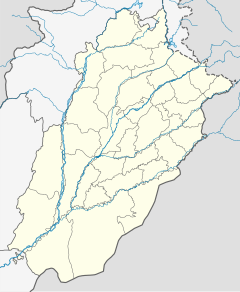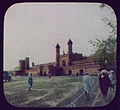Lahore Junction railway station: Difference between revisions
expanded |
No edit summary |
||
| Line 4: | Line 4: | ||
| style = Pakistan Railways |
| style = Pakistan Railways |
||
| type = |
| type = |
||
| image = |
| image = Lahore-railway-station.jpg |
||
| image_size = |
| image_size = |
||
| image_caption = <small>Lahore Junction Station Entrance</small> |
| image_caption = <small>Lahore Junction Station Entrance</small> |
||
| Line 40: | Line 40: | ||
}} |
}} |
||
'''Lahore Junction railway station''' ([[Urdu]], {{lang-pa|{{Nastaliq|'''لاہور جنکشن ریلوے اسٹیشن'''}}}}) is the |
'''Lahore Junction railway station''' ([[Urdu]], {{lang-pa|{{Nastaliq|'''لاہور جنکشن ریلوے اسٹیشن'''}}}}) is the central [[railway station]] in [[Lahore]], [[Punjab, Pakistan|Punjab]], [[Pakistan]]. It is situated at the convergence of Empress Road, Allama Iqbal Road and Circular Road. The station building is owned by [[Pakistan Railways]] and also serves as its headquarters. |
||
==History== |
==History== |
||
{{see|History of rail transport in Pakistan}} |
{{see|History of rail transport in Pakistan}} |
||
[[File:RS 0061.JPG|left|thumb|The station's design is highly militarised, having been constructed in the immediate aftermath of the [[Sepoy Mutiny|1857 Sepoy Mutiny.]]]] |
|||
[[File:Black hole walk.jpg|thumb|Inside the Station]] |
[[File:Black hole walk.jpg|thumb|Inside the Station]] |
||
[[File:Lahore_Railway_Station35.jpg|thumb|Lahore Junction Station main entrance]] |
|||
[[File:RS_0052.JPG|thumb|Lahore Junction Station view from top]] |
[[File:RS_0052.JPG|thumb|Lahore Junction Station view from top]] |
||
[[File:Lahore_train_station.jpg|thumb|Lahore Junction Station inner view]] |
[[File:Lahore_train_station.jpg|thumb|Lahore Junction Station inner view]] |
||
[[File:RS_0060.JPG|thumb|Lahore Junction Station outer wall]] |
[[File:RS_0060.JPG|thumb|Lahore Junction Station outer wall]] |
||
| ⚫ | Lahore Junction station was constructed by Mian Mohammad Sultan Chughtai, a former official of the [[Mughal Empire]], between 1859-1860. The station served as the headquarters for the [[Punjab Railway]] and later would serve as the northern terminus of the [[Scinde, Punjab & Delhi Railway]], which connected the port city of [[Karachi]] to Lahore. It was built in the style of a medieval castle to ward off any potential future uprisings, as seen in the [[Indian Rebellion of 1857|1857 War of Independence]], with thick walls, turrets, and holes to direct gun and cannon fire for defense of the structure.<ref>{{cite book|last1=Glover|first1=William|title=Making Lahore Modern, Constructing and Imagining a Colonial City|date=January 2007|publisher=Univ Of Minnesota Press|isbn=978-0816650224|quote=The Lahore station, built during a time when securing British civilians and troops against a future “native” uprising was foremost in the government’s mind, fortified medieval castle, complete with turrets and crenellated towers, battered flanking walls, and loopholes for directing rifle and canon fire along the main avenues of approach from the city}}</ref> It remains a lasting legacy of the extensive railway network established during the [[British Raj]], and reflects the British contribution to the region's infrastructure. The station was severely affected during the riots which followed the [[Partition of India|Partition of the British Indian Empire]] and the independence of [[Pakistan]] in 1947. Similar to the contemporaneous situation with migrating Muslims from [[Delhi]], Lahore's [[Hindus]] and [[Sikhs]] migrating to India were frequently attacked and killed in large numbers. |
||
The station was built during the colonial era, and was built just outside the [[Walled City of Lahore|Walled City]] at the intersection of Empress Road, Allama Iqbal Road and Circular Road. Lahore Junction station was constructed by Mian Mohammad Sultan Chughtai, a former official of the [[Mughal Empire]], between 1859-1860. |
|||
| ⚫ | The station served as the headquarters for the [[Punjab Railway]] and later would serve as the northern terminus of the [[Scinde, Punjab & Delhi Railway]], which connected the port city of [[Karachi]] to Lahore. It was built in the style of a medieval castle to ward off any potential future uprisings, as seen in the [[Indian Rebellion of 1857|1857 War of Independence]], with thick walls, turrets, and holes to direct gun and cannon fire for defense of the structure.<ref>{{cite book|last1=Glover|first1=William|title=Making Lahore Modern, Constructing and Imagining a Colonial City|date=January 2007|publisher=Univ Of Minnesota Press|isbn=978-0816650224|quote=The Lahore station, built during a time when securing British civilians and troops against a future “native” uprising was foremost in the government’s mind, fortified medieval castle, complete with turrets and crenellated towers, battered flanking walls, and loopholes for directing rifle and canon fire along the main avenues of approach from the city}}</ref> |
||
The station is a legacy of the extensive railway network established during the [[British Raj]], and reflects the British contribution to the region's infrastructure. The station was severely affected during the riots which followed the [[Partition of India|Partition of the British Indian Empire]] and the independence of [[Pakistan]] in 1947. Similar to the contemporaneous situation of Muslims fleeing [[Delhi]] and [[Amritsar]], Lahore's [[Hindus]] and [[Sikhs]] were sometimes attacked at Lahore's train station. |
|||
==Facilities== |
==Facilities== |
||
Lahore Junction Station is equipped with all basic facilities |
Lahore Junction Station is equipped with all basic facilities. The station has current and advance reservation offices for [[Pakistan Railways]] as well as cargo and parcel facilities. Retail shops are found mainly on platforms 1 and 2, including restaurants such as [[Pizza Hut]] and [[McDonald's]]. |
||
==Services== |
==Services== |
||
Revision as of 15:51, 6 May 2018
Lahore Junction Station لاہور جنکشن ریلوے اسٹیشن | ||||||||||||||||
|---|---|---|---|---|---|---|---|---|---|---|---|---|---|---|---|---|
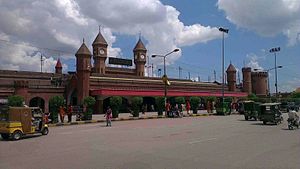 Lahore Junction Station Entrance | ||||||||||||||||
| General information | ||||||||||||||||
| Location | Empress Road Lahore, Punjab 54000 | |||||||||||||||
| Coordinates | 31°34′38″N 74°20′11″E / 31.5772°N 74.3363°E | |||||||||||||||
| Owned by | Ministry of Railways | |||||||||||||||
| Line(s) | Karachi–Peshawar Railway Line Lahore–Wagah Branch Line | |||||||||||||||
| Platforms | 11 | |||||||||||||||
| Tracks | 11 | |||||||||||||||
| Connections | ||||||||||||||||
| Construction | ||||||||||||||||
| Structure type | Standard | |||||||||||||||
| Other information | ||||||||||||||||
| Station code | LHR[1] | |||||||||||||||
| History | ||||||||||||||||
| Opened | 1860 | |||||||||||||||
| Services | ||||||||||||||||
| ||||||||||||||||
| ||||||||||||||||
Lahore Junction railway station (Urdu, Punjabi: لاہور جنکشن ریلوے اسٹیشن) is the central railway station in Lahore, Punjab, Pakistan. It is situated at the convergence of Empress Road, Allama Iqbal Road and Circular Road. The station building is owned by Pakistan Railways and also serves as its headquarters.
History


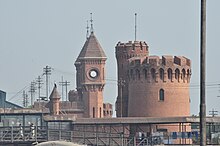

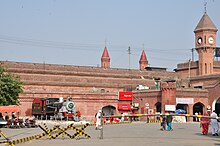
Lahore Junction station was constructed by Mian Mohammad Sultan Chughtai, a former official of the Mughal Empire, between 1859-1860. The station served as the headquarters for the Punjab Railway and later would serve as the northern terminus of the Scinde, Punjab & Delhi Railway, which connected the port city of Karachi to Lahore. It was built in the style of a medieval castle to ward off any potential future uprisings, as seen in the 1857 War of Independence, with thick walls, turrets, and holes to direct gun and cannon fire for defense of the structure.[2] It remains a lasting legacy of the extensive railway network established during the British Raj, and reflects the British contribution to the region's infrastructure. The station was severely affected during the riots which followed the Partition of the British Indian Empire and the independence of Pakistan in 1947. Similar to the contemporaneous situation with migrating Muslims from Delhi, Lahore's Hindus and Sikhs migrating to India were frequently attacked and killed in large numbers.
Facilities
Lahore Junction Station is equipped with all basic facilities. The station has current and advance reservation offices for Pakistan Railways as well as cargo and parcel facilities. Retail shops are found mainly on platforms 1 and 2, including restaurants such as Pizza Hut and McDonald's.
Services
The following trains originate/stop/terminate at Lahore Junction station:
| Preceding station | Pakistan Railways | Following station | ||
|---|---|---|---|---|
| Template:Pakistan Railways lines | Terminus | |||
| Template:Pakistan Railways lines | ||||
| Template:Pakistan Railways lines | ||||
| Terminus | Template:Pakistan Railways lines | |||
| Template:Pakistan Railways lines | Terminus | |||
| Terminus | Template:Pakistan Railways lines | |||
| Template:Pakistan Railways lines | ||||
| Template:Pakistan Railways lines | Terminus | |||
| Template:Pakistan Railways lines | Terminus | |||
| Template:Pakistan Railways lines | ||||
| Template:Pakistan Railways lines | Terminus | |||
| Terminus | Template:Pakistan Railways lines | |||
| Terminus | Template:Pakistan Railways lines | |||
| Template:Pakistan Railways lines | Terminus | |||
| Terminus | Template:Pakistan Railways lines | |||
| Terminus | Template:Pakistan Railways lines | |||
| Template:Pakistan Railways lines |
Gallery
-
General View of Railway Station 1895 by William Henry Jackson
-
Far view of Railway Station in 1880s
-
Fortifications of Railway Station 1895 by William Henry Jackson
-
Railway Station in 1880s -
Railway Station Interior View 1880s -
Train platform at Lahore Railway Station -
Lahore - entrance to railway station 1895
-
Lahore - interior of railway station 1895
-
Lahore - general view of railway station 1895
In popular culture
The film Bhowani Junction by MGM starring Ava Gardner and Stewart Granger, was shot here in 1956.[3]
See also
References
- ^ Official Web Site of Pakistan Railways
- ^ Glover, William (January 2007). Making Lahore Modern, Constructing and Imagining a Colonial City. Univ Of Minnesota Press. ISBN 978-0816650224.
The Lahore station, built during a time when securing British civilians and troops against a future "native" uprising was foremost in the government's mind, fortified medieval castle, complete with turrets and crenellated towers, battered flanking walls, and loopholes for directing rifle and canon fire along the main avenues of approach from the city
- ^ http://www.imdb.com/title/tt0049007/locations


